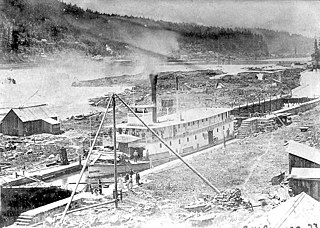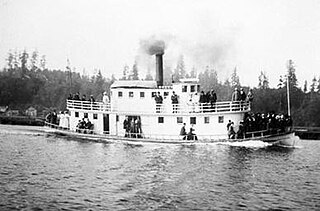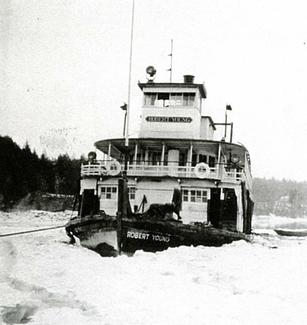Service and route
Welcome was intended to be used for passenger service on the Coquille River. [1] The route on the Coquille ran from Bandon on the coast, upriver to the county sea, Coquille, and then to Myrtle Point, which was near the head of navigation.
In 1901 only three steamers served on the river between Coquille and Myrtle Point, these were the propeller Reta (18 registered tons) the sternwheeler Echo (53 registered tons) and Welcome (21 registered tons). [3] Between these three vessels they hauled 1,554 tons of freight upriver and 2,834 tons downriver. [3] Upriver, the biggest single item was general merchandise, 800 tons. [3] Downriver was almost entirely agricultural products, with the biggest single item being 1,035 tons of milk. [3] 10,187 passengers were carried up and downriver. [3]
Stranding and rescue
On March 7, 1902, at 12:30 pm while en route to Bandon, Welcome became stranded on the north flats of the Coquille River during a very heavy squall, with the wind blowing at gale strength and a rough sea. [4] The vessel was immediately spotted by the personnel at the Coquille River Life-Saving Station, who boarded the steamer and then passed a line to the steamer Favorite. [4] Favorite however was not able to haul Welcome off the bank, and so the life-savers returned to the life-saving station in the surfboat, where they obtained an anchor, hawser, and cables, then rowed back to where Welcome was stranded. [4] They rigged the anchor to Welcome, and that night, when the tide was high, hove the vessel off the bank without damage. [4] Because the master of the Welcome was unfamiliar with the route, and the night was very dark, the keeper of the life-saving station piloted Welcome down to Bandon. [4]

Many steamboats operated on the Columbia River and its tributaries, in the Pacific Northwest region of North America, from about 1850 to 1981. Major tributaries of the Columbia that formed steamboat routes included the Willamette and Snake rivers. Navigation was impractical between the Snake River and the Canada–US border, due to several rapids, but steamboats also operated along the Wenatchee Reach of the Columbia, in northern Washington, and on the Arrow Lakes of southern British Columbia.

The Willamette River flows northwards down the Willamette Valley until it meets the Columbia River at a point 101 miles from the Pacific Ocean, in the U.S. state of Oregon.

The history of steamboats on the Oregon Coast begins in the late 19th century. Before the development of modern road and rail networks, transportation on the coast of Oregon was largely water-borne. This article focuses on inland steamboats and similar craft operating in, from south to north on the coast: Rogue River, Coquille River, Coos Bay, Umpqua River, Siuslaw Bay, Yaquina Bay, Siletz River, and Tillamook Bay. The boats were all very small, nothing like the big sternwheelers and propeller boats that ran on the Columbia River or Puget Sound. There were many of them, however, and they came to be known as the "mosquito fleet."

The Coquille River starts in the Siskiyou National Forest and flows hundreds of miles through the Coquille Valley on its way to the Pacific Ocean. Bandon, Oregon, sits at the mouth of the Coquille River on the Pacific Ocean. Before the era of railroads and later, automobiles, the steamboats on the Coquille River were the major mode of transportation from Bandon to Coquille and Myrtle Point in southern Coos County, Oregon, United States.

The Multnomah was one of the first steamboats to operate on the Willamette and Yamhill rivers. This vessel should not be confused with the Multnomah, a steamboat built in Portland, Oregon in 1885, which was larger and of a much different design.

The steamboat Oregona operated on the Willamette River, the Columbia River and the Yamhill River from 1904 to 1936. From 1924 to 1936 this vessel was known as the Interstate.

Dora was a sternwheel steamboat that was operated on the Coquille River on the southern coast of Oregon from 1912 to 1923. This vessel should not be confused with a number of other craft of the same name operating at the same time in other parts of North America.

Myrtle was a steamboat built in 1909 for service on the Coquille River and its tributaries, in Oregon. The ability of this small vessel to reach remote locations on the river system was cited many years later as evidence in support of the important legal concept of navigability.

Coquille was a steamboat built in 1908 for service on the Coquille River and its tributaries. Coquille served as a passenger vessel from 1908 to 1916, when the boat was transferred to the lower Columbia River. Coquille was reconstructed into a log boom towing boat, and served in this capacity from 1916 to 1935 or later.

Echo was a sternwheel steamboat that was operated on the Coquille River on the Southern Oregon Coast from 1901 to 1910.

Liberty was a sternwheel steamboat that was operated on the Coquille River and then on Coos Bay from 1903 to 1918. Liberty was notable for having its ownership entangled in various legal claims in the early 1910s, including some involving a colorful North Bend, Oregon business promoter Lorenzo Dow "Major" Kinney (1855-1920).

Antelope was a steamboat that was operated on the Coquille River and on Coos Bay on the southern Oregon coast from 1886 to about 1908. Antelope was a versatile boat, which served in various roles, including passenger transport, barge towing, and as a fisheries tender.

Dispatch was a sternwheel steamboat that was operated on the Coquille River on the southern Oregon coast from 1903 to 1920. The name of this vessel is sometimes seen spelled Despatch. This sternwheeler should not be confused with an earlier and somewhat smaller sternwheeler, also named Dispatch, that was built at Bandon, Oregon, in 1890, for which the 1903 Dispatch was a replacement.

Telegraph was a sternwheel steamboat that was operated on the Coquille River on the southern Oregon coast from 1914 to 1927. Telegraph is perhaps best known for having been in involved in collisions with rival steamboats, apparently as a result of fierce competition for business on the Coquille River.

Favorite was a small steamboat that was operated on the Coquille River, Coos Bay and on the Siuslaw River, in the southern Oregon coast region from 1900 to 1918.

Wolverine was a launch powered by a gasoline engine that operated on the Coquille River on the southern coast of Oregon, United States, from 1908 to the 1920s. Later the boat operated on Coos Bay, and, in the mid-1930s, was transferred to Eureka, California. Wolverine is principally known for its early service as a high-speed passenger vessel.

Little Annie was a sternwheel-driven steamboat that operated on the Coquille River on the Southern Oregon Coast from 1876 to 1890. This steamer should not be confused with a number of other vessels with the same name operating at about the same time in various parts of the United States.

Emma Hayward commonly called the Hayward, was a steamboat that served in the Pacific Northwest. This vessel was once one of the finest and fastest steamboats on the Columbia River and Puget Sound. As newer vessels came into service, Emma Hayward was relegated to secondary roles, and, by 1891, was converted into a Columbia river tow boat.

Elwood was a sternwheel steamboat which was built to operate on the Willamette River, in Oregon, but which later operated on the Lewis River in Washington, the Stikine River in Canada, and on Puget Sound. The name of this vessel is sometimes seen spelled "Ellwood". Elwood is probably best known for an incident in 1893, when it was approaching the Madison Street Bridge over the Willamette River in Portland, Oregon. The bridge swung open to allow the steamer to pass. However, a streetcar coming in from the east end of the bridge failed to notice the bridge was open, and ran off into the river in the Madison Street Bridge disaster.

Robert Young was a stern-wheel driven steamboat that operated on the Columbia and Willamette rivers from 1918 to 1935. This vessel was originally named Nespelem, and operated under that name until 1920. From 1920 to 1935, this vessel was owned by the Western Transportation Company or one of its subsidiaries, and was employed primarily in service to paper mills.



















